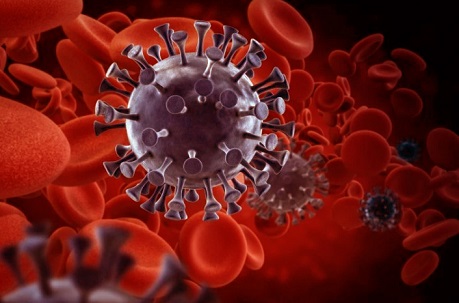Coronaviruses utilize heme and red blood cells to spread throughout the body, causing multi-organ damage
Nikhil Prasad Fact checked by:Thailand Medical News Team Nov 29, 2024 1 year, 3 weeks, 4 days, 10 hours, 10 minutes ago
Medical News: Hematology and the Hidden Pathways of Coronavirus Infection
Researchers from leading institutions, including the University of Buenos Aires-Argentina, Institut Pasteur de Montevideo-Uruguay, and the University of Ottawa-Canada, have unveiled groundbreaking insights into how coronaviruses, particularly SARS-CoV-2, impact the human body. Traditionally seen as a respiratory pathogen, this virus has shown its potential to affect multiple organs through an intricate mechanism involving blood and red blood cells (RBCs). This
Medical News report highlights key findings from a recent study, emphasizing how these revelations could redefine therapeutic approaches to COVID-19.
 Coronaviruses utilize heme and red blood cells to spread throughout the body,
Coronaviruses utilize heme and red blood cells to spread throughout the body,
causing multi-organ damage
The Role of Red Blood Cells in Disease Spread
Recent studies have pointed to the role of blood and its components in spreading coronavirus beyond the lungs. The researchers utilized a dual-modality approach, combining a mouse model infected with the Murine Hepatitis Virus (MHV) and clinical data from COVID-19 patients. High-resolution imaging demonstrated viral particles within red blood cells, proposing a novel entry mechanism through interactions between the virus's Spike protein and heme molecules.
This study explores how heme, an essential component of hemoglobin, facilitates viral invasion and systemic dissemination. Experimental results revealed that introducing heme into infected models exacerbated the disease, while treatments targeting this pathway, such as chloroquine, reduced its severity. These findings shed light on how viruses leverage blood pathways to spread and intensify disease.
Hematological Abnormalities in COVID-19
COVID-19 has long been associated with a range of blood abnormalities, such as anemia, thrombocytopenia, and altered biomarkers like ferritin and hemoglobin levels. Persistent changes in blood cell morphology and functionality have been observed even months after recovery, correlating with long COVID symptoms.
The study emphasized that RBCs might not merely be passive carriers of oxygen but could serve as hubs for viral particles. Evidence from the experiments showed that viral loads in RBC-enriched fractions were significantly higher than in plasma, suggesting a pivotal role for these cells in systemic viral distribution.
Experiments and Key Findings
In experiments, mice infected with MHV exhibited profound changes in multiple organs. Viral RNA was detected in the liver, lungs, brain, heart, and kidneys, echoing the multi-organ impact observed in human COVID-19 cases. The introduction of heme analogs into these mice resulted in elevated viral loads across organs, underscoring heme's role in viral propagation.
Additionally, high-resolution microscopy revealed virus-like particles attached to or within RBCs. Computational modeling further validated the interaction between the virus's Spike protein and hem
e, proposing that this binding facilitates viral entry into RBCs and enhances systemic infection.
Chloroquine’s Role in Mitigation
Given its interaction with heme, chloroquine was tested for its ability to counteract the virus's heme-mediated invasion. The drug demonstrated promising results, mitigating weight loss in infected mice and reducing viral RNA abundance in several organs. Hematological parameters, such as red blood cell count and hemoglobin levels, were restored to near-normal levels with chloroquine treatment.
Implications for Therapeutics
The research opens new avenues for therapeutic strategies, particularly in addressing severe COVID-19 manifestations. Targeting the virus-heme interaction could prevent systemic dissemination and reduce complications associated with blood abnormalities. Additionally, it highlights the importance of revisiting drugs like chloroquine within specific contexts, such as blood-compartment-focused interventions.
Conclusions
The study reveals that coronaviruses utilize heme and red blood cells to spread throughout the body, causing multi-organ damage. By focusing on this pathway, researchers have identified potential interventions that could mitigate severe disease. This research not only expands our understanding of coronavirus pathology but also provides a framework for developing more effective treatments.
In conclusion, the findings underline the complexity of SARS-CoV-2 as a pathogen and its ability to exploit host systems for its advantage. Future research and therapeutic approaches must incorporate these insights to enhance patient outcomes. As we navigate the evolving landscape of COVID-19, studies like this play a crucial role in shaping our response.
The study findings were published in the peer-reviewed journal: Cell Death and Disease.
https://link.springer.com/article/10.1038/s41419-024-07247-8
For the latest COVID-19 News, keep on logging to Thailand
Medical News.
Read Also:
https://www.thailandmedical.news/news/long-covid-and-the-hidden-changes-in-red-blood-cells
https://www.thailandmedical.news/news/dutch-study-sheds-light-on-hemoglobin-levels-and-fatigue-in-long-covid
https://www.thailandmedical.news/news/covid-19-news-mild-covid-19-can-cause-serious-hematological-issues-such-as-pancytopenia,-paroxysmal-nocturnal-hemoglobinuria-and-aplastic-anemia
